Tourism statistics
Data extracted in December 2023.
Planned article update: December 2024.
Highlights
62 % of EU residents made at least one personal tourism trip in 2022.
Half of EU residents' trips in 2022 were short domestic trips.
In 2022, Spain was the most popular EU destination for international tourists, with 271 million nights spent in tourist accommodation, or 22 % of the EU total.
Share of population participating in tourism, 2022
This article presents a general introduction to statistics on tourism in the European Union (EU). The data shown here are discussed in more detail in several other articles. Tourism plays an important role in the EU because of its economic and employment potential, as well as its social and environmental implications. Tourism statistics are not only used to monitor the EU’s tourism policies but also its regional and sustainable development policies.
Full article
More than three out of four residents of the Netherlands, Luxembourg, Finland, France and Austria participated in tourism
Tourism participation: 62 % of EU residents made at least one personal trip in 2022
It is estimated that 62 % of the EU population aged 15 or over took part in tourism for personal purposes in 2022, in other words they made at least one tourism trip for personal purposes during the year (such as holidays, leisure, visiting friends and relatives). However, large differences can be observed between the EU Member States, as this participation rate ranged from 27.8 % in Bulgaria to 83.7 % in the Netherlands (see Figure 1 and Table 1). The participation rate of 62 % was higher than in 2020, the first year affected by the pandemic (52 %) and 2021 (56 %), but still below the pre-pandemic level of 2019 (65 %).
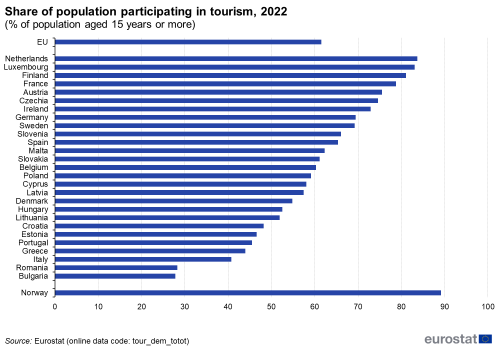
Source: Eurostat (tour_dem_totot)
More information can be found in the following article:
Tourism trips: Residents of Luxembourg, Belgium, Malta, Slovenia and the Netherlands made more foreign than domestic trips
75 % of all trips made by EU residents were inside their own country
EU residents (aged 15 and above) made nearly 1.1 billion tourism trips in 2022, for personal or business purposes. The number of trips increased by 51 % compared with 2020 and by 23 % compared with 2021, but was still 6 % below the pre-pandemic year 2019. More than half (56.4 %) of these trips were short trips of one to three nights (see Table 1). 75.5 % of all trips made were to domestic destinations, while 24.5% to destinations abroad.

(aged 15 years or more), 2022
Source: Eurostat (tour_dem_tttot), (tour_dem_totot)
In 2022, 94.5 % of the total number of tourism trips made by residents of Luxembourg were to destinations abroad, followed by Belgians with 74.5 %, residents of Malta (60.6 %), Slovenia (53.3 %) and the Netherlands (51.9 %). However, less than one out of ten trips taken by residents of Romania (8.1 %) and Spain (9.8 %) were abroad. These figures appear to be influenced by both the size of the Member States and their geographical location (smaller and more northerly countries tended to report a higher propensity for their residents to travel abroad).
In 2022, EU residents showed a preference to travel in the summer months with one fourth of their trips made in July or August.
More information can be found in the following publication:
Nights spent abroad by EU residents: Luxembourg leads in nights per inhabitant
Residents of Germany and the Netherlands spent nearly half of the total number of nights spent abroad by EU residents in 2022
EU residents spent an estimated 2.2 billion nights abroad on tourism trips in 2022 (see Figure 2). German residents spent 786 million nights on trips outside of Germany in 2022, while residents of the Netherlands spent 221 million nights abroad; residents from these two EU Member States accounted for nearly half (46.7 %) of the total number of nights spent abroad by EU residents.
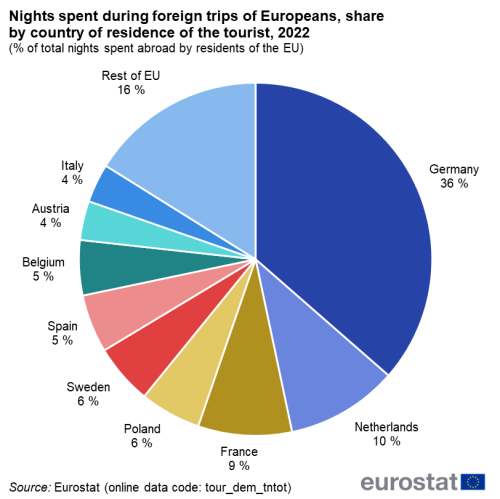
(% of total nights spent abroad by residents of the EU)
Source: Eurostat (tour_dem_tntot)
When taking into account a country’s size in terms of its population, Luxembourg was the EU Member State whose residents spent the most nights abroad per inhabitant (an average of 38 nights in 2022), followed by the Netherlands (with 15 nights spent abroad per inhabitant) and Sweden (with 14 nights spent abroad per inhabitant). At the other end of the spectrum, residents of Romania, Bulgaria, Greece, Italy and Portugal spent, on average, less than two nights abroad in 2022 (see Figure 3).
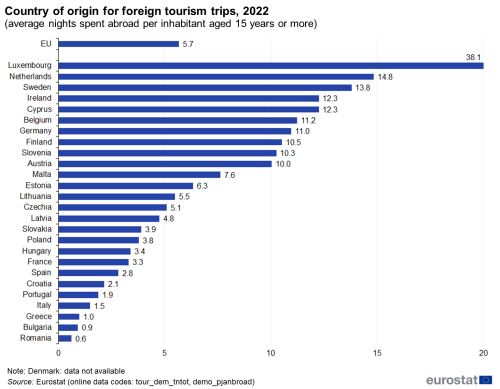
(average nights spent abroad per inhabitant aged 15 years or more)
Source: Eurostat (tour_dem_tntot), (demo_pjanbroad)
More information can be found in the following publication:
Bed places in the EU: Italy and France predominate
In 2022 35 % of all bed places in the EU were concentrated in Italy and France
It is estimated that there were more than 621 000 tourist accommodation establishments active within the EU in 2022 and together these provided 28.9 million bed places (see Table 2). More than one third (35.5 %) of all the bed places in the EU were concentrated in just two of the Member States, namely Italy (5.2 million bed places), and France (5.1 million), followed by Spain (3.8 million) and Germany (3.6 million).

Source: Eurostat (tour_cap_nat), (tour_occ_ninat), (tour_occ_nim)
More information can be found in the following article:
Nights spent by international guests in the EU: Spain on top
Nearly two out of five nights spent by international guests in the EU were spent in Spain and Italy
The number of nights spent at EU tourist accommodation establishments in 2020 dropped by more than 50 % compared with 2019. 2021 showed clear signs of recovery (see Figure 4), reaching nearly two thirds of pre-pandemic 2019 levels, while the upward trend continued in 2022, when it reached nearly 96 % of the pre-pandemic level. Short term indicators for monthly data showed that 2023 exceeded pre-pandemic levels (see Tourism statistics - nights spent at tourist accommodation establishments).

(index 2009=100)
Source: Eurostat (tour_occ_ninat)
In 2022, Spain was the most visited tourism destination in the EU for international tourists (people travelling outside their country), with 271 million nights spent in tourist accommodation establishments, or 22.4 % of the EU total (see Figure 5 and Figure 6). Half of these 271 million nights spent in Spain were concentrated in five NUTS 3 regions: Mallorca, Tenerife, Barcelona, Gran Canaria and Malaga.
The second most popular EU destination for international tourists in 2022 was Italy (201 million nights), followed by France (125 million nights), Greece (112 million nights) and Croatia (82 million nights). These five countries together accounted for nearly two thirds (65.5 %) of the total nights spent by non-residents in the EU. On the other hand, the least common EU destinations in terms of nights spent, were Latvia, Luxembourg, Lithuania and Estonia with less than 3 million nights spent by international tourists in each of these countries in 2022.

(million nights spent in the country by non-residents)
Source: Eurostat (tour_occ_ninat), (tour_occ_nim)
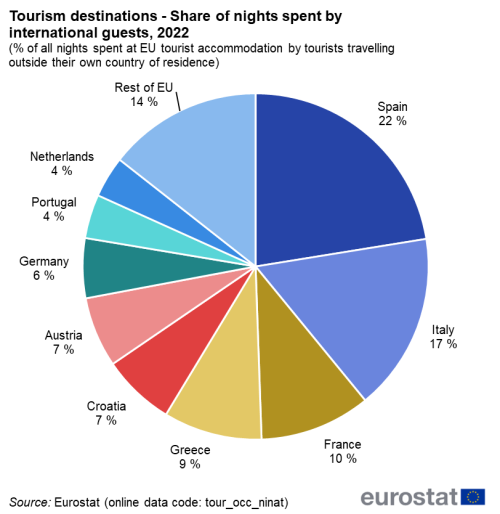
(% of all nights spent at EU tourist accommodation by tourists travelling outside their own country of residence)
Source: Eurostat (tour_occ_ninat)
The number of total nights spent (by domestic and international guests) can be put into perspective by making a comparison with the size of each country in population terms, providing an indicator of tourism intensity. In 2022, using this measure, the Mediterranean destinations of Croatia (23 nights spent per inhabitant), Malta and Cyprus (16 nights spent per inhabitant each) were on top (see Figure 7), followed by Austria and Greece (both with 13 nights spent per inhabitant).
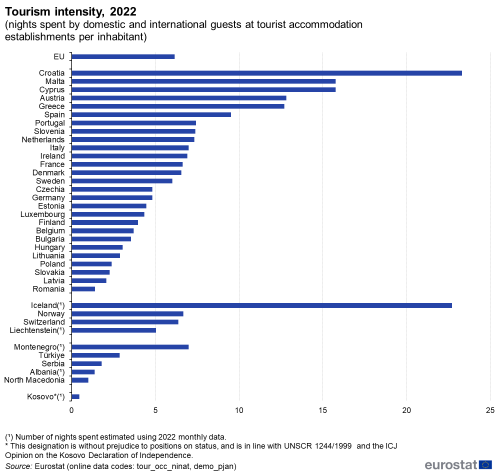
(nights spent by domestic and international guests at tourist accommodation establishments per inhabitant)
Source: Eurostat (tour_occ_ninat), (demo_pjan)
More information can be found in the following articles:
Tourism expenditure: highest spending by German residents
Germans were the biggest EU spenders on international travel, totalling €85.2 billion in 2022
The economic importance of international tourism can be measured by looking at the ratio of international travel receipts relative to GDP; these data are from balance of payments statistics and include business travel, as well as travel for pleasure. In 2022, the ratio of travel receipts to GDP was highest, among the EU Member States, in Croatia (19.3 %), Cyprus (9.9 %), Malta (8.8 %), Portugal (8.7 %) and Greece (8.6 %), confirming the importance of tourism to these countries (see Table 3). In absolute terms, the highest international travel receipts in 2022 were recorded in Spain (€69.2 billion), followed by France (€56.7 billion), Italy (€44.3 billion) and Germany (€30.0 billion).

Source: Eurostat (bop_c6_q), (bop_eu6_q), (nama_10_gdp)
Germany recorded the highest level of expenditure on international travel, totalling €85.2 billion in 2022, followed by France (€39.2 billion). When analysing this expenditure relative to the population, Luxembourg's residents spent on average €5 011 per inhabitant on travel abroad in 2022, far ahead of the second and third ranked countries, Ireland and Cyprus (€1 592 and €1 432 per inhabitant respectively), which were followed by Denmark, Belgium, Austria, Sweden, Germany and the Netherlands (all above €1 000 per inhabitant).
Spain was the EU Member State with the highest level of net receipts from travel in 2022 (€48.4 billion), while Germany recorded the biggest deficit (-€55.2 billion).
More information can be found in the following article:
Source data for tables and graphs
Data sources
Tourism, in a statistical context, refers to the activity of visitors taking a trip to a destination outside their usual environment, for less than a year. It can be for any main purpose, including business, leisure or other personal reasons other than to be employed by a resident person, household or enterprise in the place visited.
In July 2011, the European Parliament and the Council of the European Union adopted a new Regulation (EU) No 692/2011 concerning European statistics on tourism and repealing Council Directive 95/57/EC; this came into force for reference year 2012 and requires EU Member States to provide a regular set of comparable tourism statistics.
Tourism statistics in the EU consist of two main components: on the one hand, statistics relating to capacity and occupancy of collective tourist accommodation; on the other, statistics relating to tourism demand. In most EU Member States, the former are collected via surveys filled in by accommodation establishments, while the latter are mainly collected via traveller surveys at border crossings or through household surveys.
Statistics on the capacity of collective tourist accommodation include the number of establishments, the number of bedrooms and the number of bed places. These statistics are available by establishment type or by region and are compiled annually. Statistics on the occupancy of collective tourist accommodation refer to the number of arrivals (at accommodation establishments) and the number of nights spent by residents and non-residents, separated into establishment type or region; annual and monthly statistical series are available. In addition, statistics on the use of bedrooms and bed places (occupancy rates) are compiled.
Statistics on tourism demand are collected in relation to the number of tourism trips made (and the number of nights spent on those trips), separated by:
- destination country;
- purpose;
- length of stay;
- accommodation type;
- departure month;
- transport mode;
- expenditure.
The data are also analysed by the socio-demographic characteristics of the tourist:
- sex;
- age group;
- educational attainment level (optional);
- household income (optional);
- activity status (optional).
Up to 2013, tourism statistics were limited to at least one overnight stay; as of reference year 2014, foreign same-day visits are also covered by official European statistics.
Data from a range of other official sources may be used to study tourism. These statistics include:
- structural business statistics (SBS) and short-term business statistics (STS) which may be used to provide additional information on tourism flows and on the economic performance of certain tourism-related sectors;
- data on employment in the tourism accommodation sector from the labour force survey (LFS), analysed by working time (full/part-time), working status, age, level of education, sex, permanency and seniority of work with the same employer (annual and quarterly data);
- data on personal travel receipts and expenditure from the balance of payments;
- transport statistics (for example, air passenger transport).
Context
According to a United Nations World Tourism Organisation (UNWTO) publication titled ‘International Tourism Highlights’, the EU is a major tourist destination, with four of its Member States among the world’s top 10 destinations. Tourism has the potential to contribute towards employment and economic growth, as well as to development in rural, peripheral or less-developed areas. These characteristics drive the demand for reliable and harmonised statistics within this field, as well as within the wider context of regional policy and sustainable development policy areas.
Tourism can play a significant role in the development of European regions. Infrastructure created for tourism purposes contributes to local development, while jobs that are created or maintained can help counteract industrial or rural decline. Sustainable tourism involves the preservation and enhancement of cultural and natural heritage, ranging from the arts to local gastronomy or the preservation of biodiversity.
In 2006, the European Commission adopted a Communication titled ‘A renewed EU tourism policy: towards a stronger partnership for European tourism’ (COM(2006) 134 final). It addressed a range of challenges that will shape tourism in the coming years, including Europe’s ageing population, growing external competition, consumer demand for more specialised tourism, and the need to develop more sustainable and environmentally-friendly tourism practices. It argued that more competitive tourism supply and sustainable destinations would help raise tourist satisfaction and secure Europe’s position as the world’s leading tourist destination. It was followed in October 2007 by another Communication, titled ‘Agenda for a sustainable and competitive European tourism’ (COM(2007) 621 final), which proposed actions in relation to the sustainable management of destinations, the integration of sustainability concerns by businesses, and the awareness of sustainability issues among tourists.
The Lisbon Treaty acknowledged the importance of tourism — outlining a specific competence for the EU in this field and allowing for decisions to be taken by a qualified majority. An article within the Treaty specifies that the EU ‘shall complement the action of the Member States in the tourism sector, in particular by promoting the competitiveness of Union undertakings in that sector’. ‘Europe, the world’s No 1 tourist destination — a new political framework for tourism in Europe’ (COM(2010) 352 final) was adopted by the European Commission in June 2010. This Communication seeks to encourage a coordinated approach for initiatives linked to tourism and defined a new framework for actions to increase the competitiveness of tourism and its capacity for sustainable growth. It proposed a number of European or multinational initiatives — including a consolidation of the socioeconomic knowledge base for tourism — aimed at achieving these objectives.
Direct access to
- All articles on tourism statistics
- Tourism trips of Europeans (online publication)
Main tables
- Tourism (t_tour)
- Trips of EU residents - annual data (ESMS metadata file — tour_dem_esms)
- Capacity and occupancy of tourist accommodation establishments (ESMS metadata file — tour_occ_esms)
- Methodological manual for tourism statistics
- Agenda for a sustainable and competitive European tourism (Communication from the European Commission, October 2007)